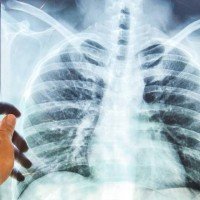Current Statistics
Lung cancer is the most common cancer among men and the third most common cancer among women in Hong Kong. According to the Hong Kong Cancer Registry of the Hospital Authority, there were 5,575 cases of lung cancer in 2019, accounting for 15.9% of all cancers. Among all the cases, 3,424 were in men and 2,151 were in women, showing a male to female ratio of about 1.6 to 1. The majority of patients are over 40 years old, with a median age of about 70 years. The cumulative risk of lung cancer by age 75 is 1 in 20 for men and 1 in 35 for women.
What is Lung Cancer?
Lung cancer is caused by abnormal cell growths in the lungs. It can be classified into non-small cell carcinoma (including lung adenocarcinoma, squamous cell carcinoma, and large cell carcinoma) and small cell lung cancer (SCLC), and the most common type of lung cancer in non-smokers is adenocarcinoma.
Symptoms of Lung Cancer
There are usually no obvious symptoms in the early stages. The following symptoms may occur when lung cancer has progressed to a certain stage. If symptoms appear and persist for two weeks and do not go away after treatments, there is a possibility that the condition is not normal.
- Persistent cough
- Blood in sputum
- Repeated or prolonged infection of the chest and lungs
- Hoarse voice
- Discomfort in chest, pain when coughing or breathing deeply
- Loss of appetite and weight loss
- Easy to feel tired
Major Known Causes of Lung Cancer
According to the Cancer Fund, as many as 90% of lung cancer cases are related to smoking, and about one in ten smokers will eventually develop lung cancer. Long-term exposure to air pollution may also increase the risk of lung cancer, especially in those with high genetic risk. Exposure to radon and other carcinogens such as arsenic, chromium, and asbestos will increase the risk of lung cancer as well.
Risk factors for Lung Cancer
- Age 45 or older
- Smoking
- Exposed to secondhand smoke
- Family inheritance
- Exposure to carcinogens (such as arsenic, beryllium, cadmium, chromium, nickel, asbestos, silica, quartz, bis(chloromethyl) ether, chloromethyl ether, coal, tar, asphalt, cigarette ash, mustard gas, diesel, exhaust gas, and particulate matter 2.5)
- Radiation (such as alpha particles, radon, plutonium-239, x-ray, and gamma ray)
How is Lung Cancer Diagnosed?
- Screening: Low-dose spiral CT scan is the only effective screening method to detect early-stage lung cancer. In high-risk groups, it can reduce lung cancer mortality by 20%.
- Preliminary examinations: Chest x-rays are used to get a simple amd rough image of the lungs, and sputum tests are often used to detect infections or cancer cells shedded in the sputum.
- Advanced imaging examinations: Computerized tomography (CT scan) is more effective in detecting very small shadows 3-dimensionally. It can also be used to determine whether the lymph nodes are enlarged or any fluid collection. PET-CT scans are more sensitive in detecting cancer or metastases. Magnetic resonance imaging (MRI) are particularly useful to detect any pathology in the brain.
- Biopsy: Small pieces of tissue from the lesion will be removed with a needle or by surgery for pathology and molecular classification, which is the gold standard for confirming and determining the type of lung cancer a patient has.
- Liquid biopsy: By analyzing the circulating tumor DNA that is in blood or other body fluids, which is released during the cancer cell lysis, patients can be examined for genetic mutations with a sensitivity of about 70-80%. This is suitable for patients who cannot undergo regular biopsy because of the inaccessible location of the lesion and it can provide guidance for targeted therapy.
Treatments for Lung Cancer
There are many treatments available to effectively manage lung cancer, from surgery and chemotherapy to newer targeted therapy and immunotherapy, all of which can help patients fight against lung cancer.
For early-stage non-small cell lung cancer, surgery and radiotherapy are the main forms of treatment. Radiotherapy, chemotherapy, targeted therapy, or immunotherapy may be as adjuvant therapies, depending on the patient’s risk factors.
Intermediate-stage non-small cell lung cancer can be treated with concurrent radiotherapy and chemotherapy, supplemented with immunotherapy. There is still a chance of long term control and survivorship.
In advanced non-small cell lung cancer, chemotherapy, targeted therapy, immunotherapy, or a combination of these approaches are used to alleviate symptoms and prolong survival, depending on the pathology and molecular classification of the cancer cells.
Treatment for small cell carcinoma is mainly in the form of chemotherapy and immunotherapy (if the cancer has already metastasized), supplemented with thoracic radiotherapy and prophylactic whole-brain radiotherapy.
Surgery
The lung cancer tumor and some surrounding tissue would be removed by surgery. The scale of surgery varies, depending on the size, stage and metastasis of the tumor. Some may require only partial removal of lung tissue or one lobe, while others may require total lung resection.
Radiotherapy
Radiotherapy can be used as a local treatment for early-stage and intermediate-stage patients who are not suitable for surgery due to age or other medical conditions. For patients with advanced lung cancer, it can also relieve symptoms such as tracheal or venous obstruction, pain due to bone metastases, or symptoms from brain metastases.
During the process, radiation would be targeted at the tumor from the outside. Radiation can also go through a small needle or a catheter that is placed inside the body for the treatment. The latest technology includes stereotactic body radiation therapy (SBRT), intensity-modulated radiation therapy (IMRT), and image-guided radiation therapy (IGRT), which allows for more precise radiation to the tumor without damaging the surrounding tissue. Tomotherapy is a more advanced implementation of IMRT.
Chemotherapy
Anti-cancer drugs that are toxic are used to kill cancer cells and stop them from growing. Chemotherapy can be given before or after surgery to shrink the size of the tumor or to reduce the risk of recurrence. It can also be used in patients with advanced lung cancer to alleviate the symptoms.
Targeted Therapy
This treatment is based on the patient's genetic test results—to see if the patient has any genetic mutations such as EGFR, ALK, ROS-1, RET, NTRK, MET, BRAF, RAS, HER2, etc. If these genes are found to be present in the patient's body, the corresponding drug can be used.
There are many types of targeted therapies available. Some therapies block the growth signals in cancer cells, thus preventing the cancer cells from growing. Another type of therapy is anti-VEGF, which inhibits the creation of new blood vessels in cancer cells and starves the cells to death.
Immunotherapy
It makes use of the patient's own immune response mechanism to fight against cancer cells. Immunotherapy can awaken the dormant T cells in the body's immune system, so that they can recognize and attack the cancer cells. The side effects are generally mild. Besides for late stages, it can also be used as an adjuvant therapy before or after surgery for early stages to improve the survival and decrease recurrence.

























